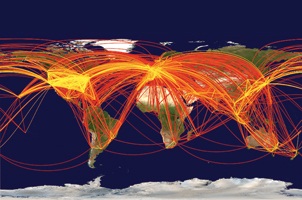Today’s world is a global village with growing concentrations of people in huge cities, mass migrations forced by social or economic pressures, and accelerating commerce and travel. More than 3 million airline passengers cross international borders daily, creating routes by which human infections can radiate around the world within hours. The crates and containers in which goods are shipped worldwide provide safe passage for disease
vectors and animal pathogens.
The 2009 “swine flu” pandemic starkly illustrated the impact of globalization and air travel on the movement of infectious diseases—with the infection spreading to 30 countries within 6 weeks.
Building roads in previously undeveloped areas brings people into contact with new environments and potentially new pathogens. Cruise ship travel has increased, bringing together—often in confined spaces—thousands of people from diverse geographic regions (including countries with
immunization requirements that differ significantly from those of the various sites where the ships’ passengers disembark). And, as adventure travelers intrude on new environments and make contact with exotic wildlife, they may encounter
microbes that have never before been recognized as human pathogens.
In this rapidly shifting and interconnected world, infectious agents continually find new niches. The 2009 “swine flu”
pandemic starkly illustrated the impact of
globalization and air travel on the movement of infectious diseases—with the infection spreading to 30 countries within 6 weeks and to more than 190 countries and territories within months.

The movement of people around the globe, depicted here in a map of air traffic among the 500 largest international airports, can lead to the rapid spread of infectious disease.
Reprinted with permission from L. Hufnagle, D. Brockmann, and T. Geisel. Copyright 2004 National Academy of Sciences.
The human population is undergoing a mass migration from the countryside to “megacities.” Throughout history, big cities have been great incubators of infections—with outbreaks of respiratory, gastrointestinal,
meningeal, and skin infections becoming common in crowded urban settings. Substandard housing and inadequate sewage and water management systems harbor rats, mosquitos, and fleas, all of which spread disease. Poor access to health care services and lack of surveillance allow diseases to spread unchecked.
Globalization of the food supply has spread foodborne disease caused by bacteria such as
Salmonella,
E. coli, and
Campylobacter. The United States, for example, imports about 20 percent of its fresh vegetables, 50 percent of its fresh fruits, and more than 80 percent of its fish and seafood. As wealthy nations demand such foods year-round, the increasing reliance on producers abroad means that food may be contaminated during harvesting, storage, processing, and transport—long before it reaches overseas markets. Efforts are being made to improve food safety in the countries where it is produced.
Food is not the only globally traded product to set off waves of infection. In 1999 the fungus Cryptococcus gattii emerged on Vancouver Island, British Columbia, Canada, causing a growing epidemic of human and animal infections and deaths. It has since spread to the Pacific Northwest in the United States and has been seen in Southern California. In these regions, this fungal pathogen has been associated with 338 confirmed human infections, 40 deaths, and represents the largest documented population of C. gattii–infected people in the world. The fungus, which causes deadly infections of the lung and brain, had previously been found in only tropical or subtropical climates in regions such as Africa, Australia, Southeast Asia, and the South Pacific. The exact origins of this outbreak remain a mystery, but some researchers suggest that the fungus may have been introduced through the importation of contaminated trees, shoes, wooden pallets, or shipping crates.

